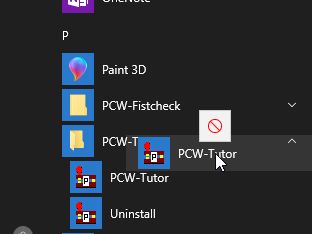
Welcome to the Precision CW Tutor help page.
I sincerely hope that the information herein will help you to make better use of
Precision CW Tutor.
These help pages are valid for version 6.9.10 and later versions.
Precision CW Tutor or PCW Tutor is a piece of software, written for PCs running the Windows operating system. It was primarily intended as an aid to train the ability to read International Morse Code by ear. Over time many features have been added and now this software does cover a broad range of applications.
PCW Tutor can be used:
If you are training your Morse code abilities all by yourself, or if you are running a Morse code class, PCW Tutor will be there to assist you in various ways.
You can download the software in a zipped archive from the Precision CW Download Page. Save the archive file on your computer and remember the location.
Go to top.As long as you utilize Precision CW Tutor for your private and personal use, you are granted a personal, non-exclusive and unlimited license, completely free of charge. Any commercial use of this software without a written license agreement is prohibited. If you would like to conclude such a license agreement, then please contact the author.
Go to top.Double-click on the saved archive file. The archive should open and display a single file:
(The version information "6.9.0" may be different.)
Start the installation by double-clicking on the executable file.
A welcome window will open. Click "Next" and the license agreement will be displayed.
If you agree to the terms of the license agreement then you should check the "I agree ..." box and
click on the "Next" button. Then installation will start.
The installation process is simple, there are no new DLLs, no additions to the registry file, and no changes to
your operating system. An entry will be added to the startup menu and an icon will be placed on your desktop.
The installation can be reversed, very probably without a trace left.
I'm afraid there is no other way than to just go on and trust me. Switch off your Antivirus system while you install PCW Tutor. And in case your Windows OS is complaining as well, there should be a button like "do it anyway" or "I know what I'm doing". Try this.
There is a chance to increase trust in the installer software package: On the page you used to download the installer software, I have published the SHA256 checksum for exactly this software package. After downloading the file, you can yourself calculate the SHA256 checksum for that specific file you now have on your PC. And when those two checksums are identical, you can be sure that you have the original file and nobody has tampered with it.
To calculate the SHA256 checksum you need another piece of software, e.g. Hashing for Windows. And this is easy, free and open source. You can get it from here: Hashing App.
Go to top.
On certain installations of Windows 10 the automatic placement of an icon on the desktop may be prohibited. In this case you have to locate the program "PCW-tutor.exe" on your computer.
With a right-click you open the context menu and then choose "shortcut".
In Windows 10 you can as well go to the Start Menu List and locate the entry for PCW-Tutor. By left-clicking on the icon you can drag it onto your desktop.

You either double-click on the PCW-Tutor icon on your desktop or you go to "Start" - "Programs" and locate the "PCW-Tutor" entry. Double-click on "PCW-Tutor", the program will start.
Go to top.First you will see the main operating window. Here is a view of the upper left corner.
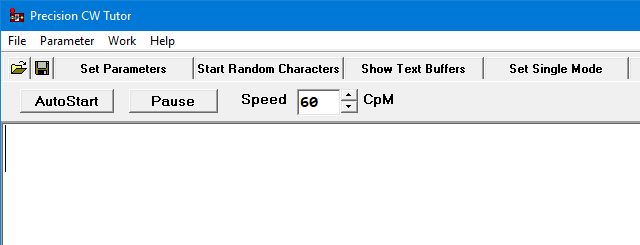
Right now you are in Keyboard Mode, and you can use the program as a Morse Code Keyboard. There are many other modes, which have especially been designed for training Morse code.
Now, try to press a few keys on your computer's keyboard.
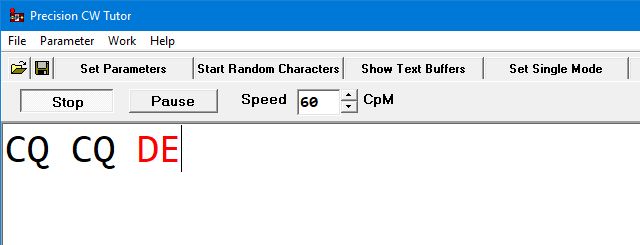
You will notice that the typed characters on the screen are first colored in red, then turn black while the Morse characters are sounded. This means, you can type ahead and wait for the program to complete the Morse characters in the appropriate way and with the speed chosen. This sequence of display and sound is characterised by Show first, then Sound, which is appropriate for a Morse keyboard. When you use the software for Morse training, especially when doing that all by yourself, it may be better to use Sound first, then Show. We will talk about that in a later chapter.
If you see red letters turning black in the window but you don't hear anything, then a few things need to be adjusted (see further below).
The main screen keyboard operation by itself has two modes: AutoStart (the default, which is shown above), and ManualStart (which replaces the AutoStart button). First we will discuss the AutoStart operation.
You will notice that the moment you type a character, the AutoStart button is depressed and turns into a Stop button. It comes up again after the last character has been sounded. This characterizes the AutoStart mode.
Again, type a few more characters, let some Morse characters be sounded, then hit the ESC key. You will notice that immediately all red characters in the window disappear and type-ahead is stopped. Equally well you can click on the depressed Stop button. It will come up again and type-ahead is stopped as well.
At this point, more typing will continue from the end of black text. And, as long as AutoStart is selected, sounding of Morse characters will start immediately.
ManualStart is the non-default mode of the main screen, it is selected in the Set PCW Parameters window. Turning AutoStart to "off" will relabel the AutoStart button to ManualStart.
When the AutoStart feature is deselected on the Set PCW Parameters window, you can still type characters you like to send, and these characters will appear colored in red. However, transmission will not begin immediately, it will only start when you click on the ManualStart button.
In most cases you can momentarily stop the transmission of Morse characters by clicking on the Pause Button. This button then turns into a Resume Button. At this time any pending Morse character will be completed, then the processing is paused. A further click on that button, and processing will be resumed.
You can as well interrupt and resume the Morse transmission by pressing the Pause/Break Key on your keyboard.
In some cases, especially for the speed test, the use of the Pause Button or Pause/Break Key is inhibited.
You can clear the screen by depressing the Del/Delete key or by pressing the Ctrl and Z keys together.
Note that the AutoStart on/off setting also applies to text read from a file, which is covered here.
Go to top.Here is the list of keyboard shortcuts that can help you to control PCW Tutor.
These can be used from the Main Window:
There are many ways to influence how the program behaves.
The actual speed of the Morse code generator is shown on the main window. Speed is given in CpM, characters per minute. In case you prefer speed given in WpM, words per minute, we'll come to that shortly.
You can change speed by clicking on the small (▴) and (▾) buttons to the right of the speed display. Speed normally changes in increments of 1 CpM or 0.2 WpM. But when you press these cursor keys or click with your mouse together with one of the two SHIFT keys, the increment value changes to 10 CpM or 2 WpM. When you press SHIFT and CTRL together, the increment value is 100 CpM or 20 WpM. This can be a fast way to adjust the desired speed. And if you desire a really large speed change, you can type in the text box, but you must hit ENTER for the change to take effect.
Many more items can be adjusted in the Set PCW Parameters window. You reach this by
clicking on the Set Parameters button or by simply pressing F2.
You should notice that
all changes and adjustments have immediate effect, it is not necessary to close this window first.
The Set PCW Parameters window is separated into three panels: left, top-right and below-right.
Let's first look at the top-right sub-panel. On this panel you have control
over theMorse Output Parameters.
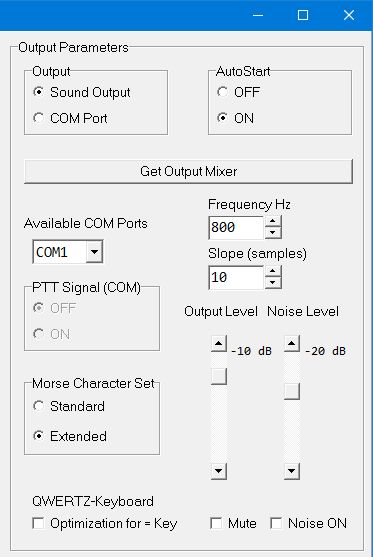
On the Output Parameters sub-panel you can choose between sound output via your PC's loudspeakers, headphone or line output, and output via a RS-232/COM computer interface. If your PC doesn't have a RS-232/COM interface (most laptops don't), this choice is not available and grayed out.
If you use the sound output, you can change the sound Frequency from the typical 800 Hz to a value that pleases you. The attack and decay slopes of the audio signal are smoothed a bit. This Slope is given as a number of audio samples. You can experiment with that value: smaller values give a more "clicky" signal, while larger values give a more "smooth" sound. When you are not sure what to do, then stay with the value of 10.
You also can change the volume of the signal output with the Output Level control and you can altogether mute the ouput signal by checking the Mute checkbox. Furthermore, you can add noise to the output signal by checking the Noise ON checkbox and adjust its level with the Noise Level control.
If you like to use the RS-232/COM interface output, you first have to select the appropriate COM
number. Only such COM interface numbers can be chosen that are actually available on your computer. In case
there is more than one COM interface on your computer, you
have the choice for more than one COM number. Here you have to experiment a bit to identify the number that
corresponds to exactly that interface you want to use.
More information about the use of RS-232/COM interfaces is here.
You can further choose whether to support the standard or the extended Morse Character Set (see here for further explanation) for the output of Morse signals.
Finally you can check a box to select a small optimization for users of so-called QWERTZ keyboards, which will mostly be users of Windows set to the German language.
On these PC keyboards two keystrokes are needed to produce the frequently needed <BT> prosign, the dash or equal sign: The "shift" key and the "0" key have to be pressed together. Therefore an optimization is provided:
Normally the following relation between keyboard and Morse characters is in effect:
But when you check the "= key optimization" checkbox, then the following relation between keyboard and Morse characters is in effect:
Users of so-called QWERTY keyboards and all other versions should leave this box unchecked.
Go to top.Then let's look at the smaller below-right sub-panel. Here you have control over some Display Parameters:
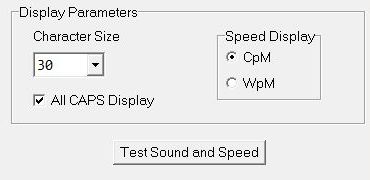
You can change the size of the characters on the main screen, and you can select the All CAPS feature to display all characters in uppercase.
Furthermore, you can change the display of Morse speed from CpM (characters per minute) to WpM (words per minute). Between both versions there is a constant multiplication factor of 5; 12 WpM correspond to 60 CpM.
And, finally, below that panel, there is a button labeled Test Sound and Speed. When you press this button, then the word TEST is constantly sent out in Morse code. With this you can adjust the parameters for sound frequency, slope, and output level. You can adjust the Morse speed on the main window, and select and listen to the various versions using the Farnsworth / Wordsworth method. Stop this sound and speed test by pressing <ESC>.
Go to top.Now let's look at the left hand sub-panel. Here you have control over the Tutor Parameters:
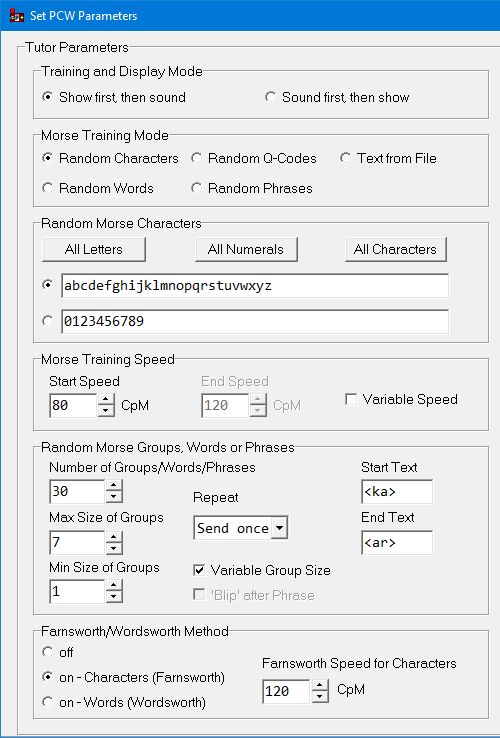
You first have to make up your mind, whether you want to see the characters first on the screen, and then hear the sound of Morse code "Show first, then sound", or the other way round "Sound first, then show". The first is appropriate when you use the software as Morse keyboard, the latter one can be more appropriate when you want to train reading Morse code, especially for Instant Word Recognition. Both versions have influence on how the various training modes actually work.
Then you can select the Random Morse Training Mode you want to use in your training session. Five different modes are available:
Then, for Characters Mode, you can select the Morse Characters you want to use in the training session. Two separate and selectable entry fields are provided, so you can easily switch between two training sets. Each of these entry fields has room for up to 80 characters. The minimum number of characters is limited to only one, to enable training of just one single character. Of course, with just one defined character there will not be much randomness in the Morse output.
For your convenience, buttons for
"All Letters" (a-z),
"All Numerals" (0-9),
and "All Characters" (a-z 0-9 .,/?<bt>) are provided. "All Characters"
in this context means that the standard 26 letters, 10 numerals, 4 punctuation marks and the very often used
<BT> prosign can be entered with one click into the active entry field.
If you like to include more or other prosigns into your training session, then you can either enter their keyboard
shortcuts or their long form with angle brackets like <AR>. More information on the supported prosigns is here
You can enter any character into each of the character entry fields, but only those characters or prosigns with an actual representation in Morse code will be retained. And this of course also depends on your previous choice of either the standard or the extended character set on the Output Parameters panel.
Furthermore, you can increase the probability of appearance for one or more characters by entering them more than once into the entry field.
For each of the five training modes with random characters, words, Q-codes, or phrases, and for text, the Morse training speed can be chosen next. This value can be different from the speed value you may have set on the Main Window. When you start a training session with F3, then the actual training speed is taken from this field and displayed on the Main Window. Still, unless you have selected automatically variable speed, you can manually change the actual Morse training speed on the Main Window while a session is running.
When you check the Variable Speed On checkbox, then the training speed will be variable over the selected set of random groups, words, Q-codes, phrases or words from text. Speed will vary from Start Speed to End Speed. In this case the actual speed is automatically changed from character to character or word to word, while the manual speed change on the Main Window is blocked.
Random Characters are produced in Groups of defined length, separated by a blank space. The Size of Groups and the total Number of Groups/Words can be adjusted. And when you check the Variable Group Size checkbox, the length of a group will randomly vary between the selected values for Max Size of Groups and Min Size of Groups. The selection box for minimum size of groups will always show a value that is lower than the value in the selection box for maximum size of groups. When the Variable Group Size checkbox is not checked, then the value in the selection box for minimum size of groups is not visible.
Random Q-Codes are similar to Random Groups, only their length is fixed to three letters. And of course, they all start with the letter "Q"
You can select to render each item of groups, Q-codes, or words either only once, or to Repeat each item up to 5 times. Here you can find more on this.
Each random session starts with the Start Text, pre-set to "vvv<ka>", and ends with the End Text, pre-set to "<ar>". You can change these to suit your needs.
When listening to a phrase of Morse characters, especially in "sound first then show" mode, you may find it useful to be alerted when the phrase has ended. For this a special alert sound is provided. You can switch it on by checking the box labeled 'Blip' after Phrase. Here you can read more.
A further and important feature of Precision CW Tutor is the adoption of the Farnsworth Method for Morse teaching. The type of Farnsworth Method and the Farnsworth Speed can be selected. You can find more on the Farnsworth Method in the following chapter.
Go to top.For many decades, a typical Morse training course for beginners was started with a low overall speed (defined as the rate of delivery of characters) like 30 CpM or 6 WpM. When recognition of Morse characters was sufficiently mastered, the training speed was increased step by step until the target speed for final examination had been reached or even exceeded.
A clear drawback of this procedure is, that at each increase in speed everything sounds different, as the length of dits, dahs and spaces changes accordingly. And the learner virtually has to start over again. Experience has also shown that starting with a very slow rate can encourage the user consciously or subconsciously to develop bad habits which will hinder progress. When the training speed is set too slow, then instead of hearing a character as a distinct sound, the user may try to analyze the individual sounds that compose a character - such as counting the dits and dahs, forming visual pictures of the timing elements or drawing comparisons between characters (i.e. this character is the reverse of that one).
Therefore beginners have been advised to set a minimum training speed of at least 15 wpm (some say 20), thus preventing some of these pitfalls. For many users this works fine, and they build instant character recognition (ICR). Unfortunately, it didn't work for all learners.
The Farnsworth method of code instruction was designed to avoid these pitfalls. It was named after Donald R. "Russ" Farnsworth, W6TTB (sk). For quite some time it was believed that he created this learning method in the late 1950s (*1), but research in the related literature has revealed that already in 1932 Dutch psychologist Rebekka "Betty" Biegel had used and published (*2) this method, together with some favourable training results. But this method still has earlier roots. Its first appearance in connection with International Morse Code seems to be in a 1917 document by the US government (*3).
With this method, named after "Russ" Farnsworth, a high and CONSTANT speed is used for each Morse character, right from the start. In PCW Tutor this speed is called the Farnsworth Speed. Further, the inter-character and inter-word gaps are INCREASED - some call this "think time". This increase leads to a lower overall rate or speed, called Morse Training Speed. As learners progress, the initially increased time spaces are shortened and thereby the Training Speed increased, until finally a Training Speed equal to the Farnsworth Speed for characters or words is reached.
Of course, when the Morse Training Speed is chosen to be larger than the Farnsworth Speed, then there are no more previously increased gaps left to be shortened again, and the Morse characters have to be formed according to that faster speed. In this case the setting for Farnsworth Speed has no effect.
Precision CW Tutor gives you 3 choices for the application of the Farnsworth Method:
This last choice, where only the inter-word-gaps are made longer, has been named the "Wordsworth" method by George, K1IG, in QST in May 2017 (*4).
The chosen mode (Farnsworth or Wordsworth) is also shown on the main window, adjacent to the speed indicator.

The ARRL has chosen the Farnsworth Method as standard for their Morse training courses, with Farnsworth Speed set to 90 CpM or 18 WpM (see QEX April 1990, p 8-9).
(*1) Peter Carron, W3DKV, in his 1991 book "Morse Code: The Essential Language" states (page 4-3): " The true origin of the Farnsworth method is still a mystery. It is possible that various amateurs used it at different times, each finding it to be a superior method of code instruction, and as a result it eventually became the commonly used technique that it is today."
(*2) Biegel, R. A.: Das Anlernen der Höraufnahme durch Funkentelegraphisten, Psychotechische Zeitschrift (1932) vol 7 pp 147-151 This paper is written in German, a translation into English is available from here.
(*3) Anon.: Training conscripted men for service as radio and buzzer operators. Federal Board for Vocational Education, Bulletin No. 2, Washington: Gov't Printing Office, Oct. 1917
(*4) George Allison, K1IG: Increase Your CW Speed with Wordsworth, QST, May 2017, pp 74-75
Go to top.Numerous ways have been proposed to approach the task of learning a new language, and learning to read Morse code by ear is a similar task. What has worked for me and the many Morse classes I held is a set of simple rules - and a PC with Precision CW Tutor running, basically unchanged since its first use in 1991.
Here is the order in which I normally introduce new characters into training sessions:
qs e m t a d j i r c 5 n l g Ø u b 4 1 h o z y 6 9 k w 2 7 f x . ? 3 8 p v , / =
And, just for your convenience, here is a paper form that helps you to write down the decoded characters in groups of five.
When you are at least half-way through the list of all Morse characters, you should gradually start to listen
to real words or abbreviations and phrases typically used in Amateur Radio communication.
For this you can load any text file into the main window and try to decode the Morse characters. But you may need
to specially prepare the text file to contain only those characters you are already mastering. Luckily,
there is software available to support you in this respect:
Have a look at
MCPT Morse Code
Practice Text by WA2NFN.
Random Characters Mode supplies you with random Morse characters that are taken from a list you can define. These Morse characters are presented in groups of a selectable length (typically 5) or randomly picked length, with a space between them that corresponds to a space between words. To use Random Characters Mode, you first have to select the desired parameters on the left pane of the Set PCW Parameters window:
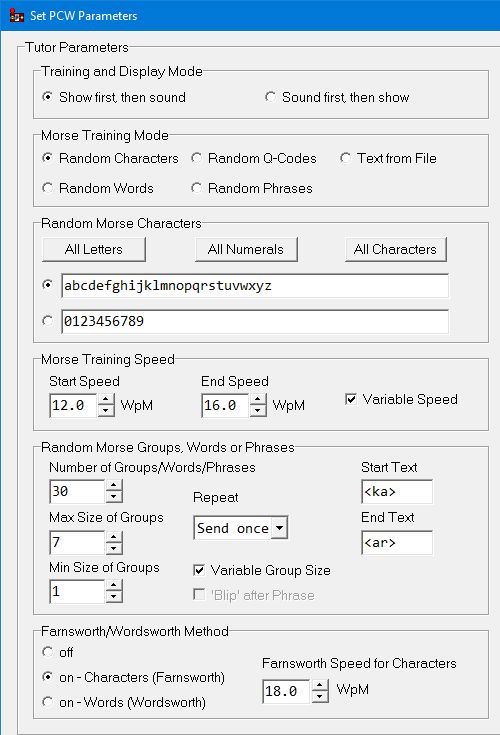
For a start, select the Show first, then sound mode, then select or enter the Morse Characters you want to include in the test, then select the Number of Groups and the Size of Groups, fixed or randomly varying. You can even select a group length of "1", and that means that you will get single characters with word spaces between them.
Then select the desired Start Speed. If you like to have automatically increasing (or even decreasing) speed, then you should check the Variable Speed On box and adjust the desired End Speed.Don't forget to select the desired variant of the Farnsworth Method and the Farnsworth Speed.
Then hit ESC or F2 again, and go back to the main window. Now click on the Start Random Characters button or press F3. The Start Random Characters window will appear, telling you what will happen next.
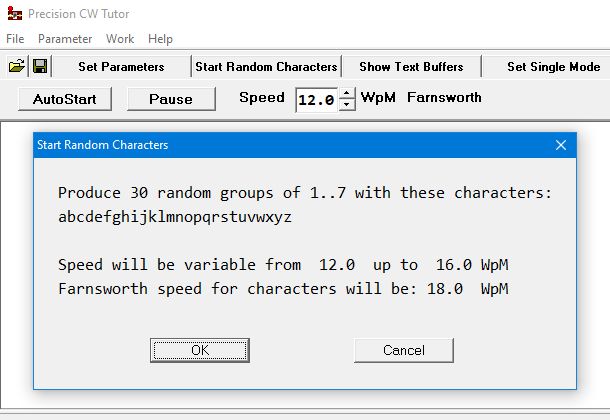
Hit the RTN key or click on the OK button and off you go. First the Start Text is sent, and then random characters are taken from the pre-defined list.
Please note that the initial training speed is taken from the Start Speed field in the Set Parameters Window, the speed setting on the Main Window is overwritten at the start.
While Random Groups are running and if you did not select Variable Speed, you can still adjust the speed with the up-down cursor keys at your will.
You may find that the letters on the screen distract you from listening to the Morse characters. Then there is a simple solution: Click on the Hide Text Button. All text on the Main Window is hidden and the caption on the button turns into Show Text, indicating what you should do after your training session has ended.
After all groups have been keyed, the End Text is sent and you get a confirmation message that tells you the actual Morse speed according to the time elapsed for that number of characters. In case you had selected Hide Text before, you have to click on the Show Text button to actually see the characters sent and this final confirmation message.
Here is an example where the characters [qsemtadjirc5nlgØ/], organized in 30 groups of constant length 5, and a constant speed of 12.0 WpM / 60 CpM had been used:
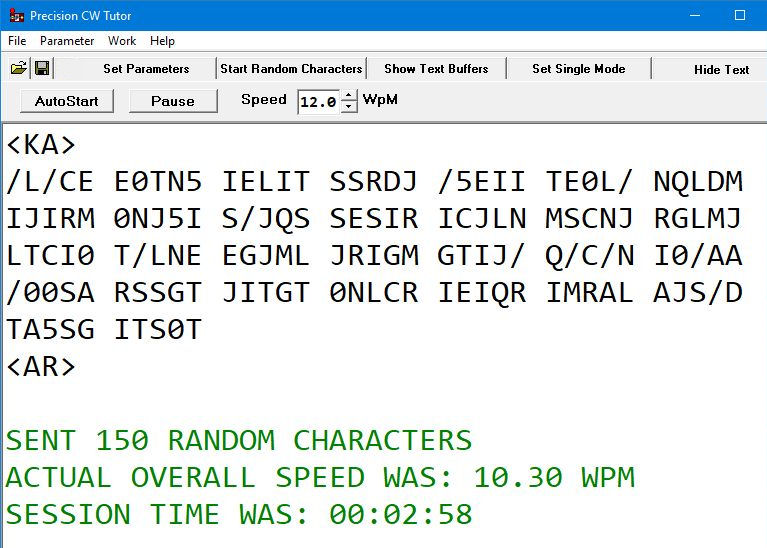
The display shows that 150 random characters have been sent with a nominal speed of 12.0 WpM. And the actual speed, as measured by the elapsed time, was 10.30 WpM. Additionally, the total elapsed session time is given.
If, for whatever reason, you have to stop the session, then simply hit the ESC key. The session will stop after sending the End Text and a confirmation message.
Go to top.Random Words Mode is similar to Random Characters Mode with varying group length. The main difference is that more or less meaningful groups of characters are used. And these meaningful combinations of characters or words are entirely up to you. You have to make up your mind on which words should be used in the training session, then prepare an unformatted .txt file that contains these words. And these words can be separated either by blank spaces or each of them in a new line. Then, when you press CTRL+W (or the related menu entry in the File Menu) and select this file, these words are read into memory, and a message is shown, telling you how many separate words have been identified. It is possible to load up to 1000 separate words. When your file contains more than 1000 words, then the excess words are not loaded and not used.
Please note that after loading the words into memory, the Morse Training Mode is automatically set to "Random Words", assuming that you now want just that, and thereby saving you some clicks with the mouse. And when you now press F3, a random selection from these words is presented until the selected Number of Groups/Words for a session is reached.
Again, if, for whatever reason, you have to stop the session, then simply hit the ESC key. The session will stop after sending the End Text and a confirmation message.
Go to top.Random Q-Codes Mode is very similar to Random Words Mode. You select this mode on the top-left panel of the Set Parameters window. In this mode the Random Groups or Random Words have a fixed length of 3 characters and all start with the letter "Q".
These Q-codes did once play a prominent role in wireless communication and still some of them do in Amateur Radio. Precision CW Tutor gives you a way to train them separately. A large number of Q-codes does exist, but only a subset of 26 of the most used Q-codes in Amateur Radio have been implemented in PCW Tutor and the random Q-codes are taken from this list.
It is highly recommended to train Q-codes with Farnsworth mode set to "on - Words". This should help to build Instant Word Recognition with Q-codes.
And here is the list of the 26 implemented Q-codes:
qra, qrg, qrl, qrm, qrn, qro, qrp, qrq, qrs, qrt, qru, qrv, qrx, qrz, qsb, qsd, qsk, qsl, qso, qsp, qst, qsx, qsy, qtc, qth, qtr
And just in case you want to use different Q-codes or other special combinations, then you can simply prepare a text file with these codes and use it in Random Words Mode.
Go to top.Random Phrases Mode is similar to Random Words Mode. A phrase can be as simple as a single letter or word, or consist of a larger number of words. And these phrases are entirely up to you, but a good use for this might be to get used to typical QSO phrases like "ur rst is 589".
To use this mode, you have to prepare an otherwise unformatted .txt file. Each line of text in this file qualifies as a phrase. Then, when you press CTRL+P (or the related menu entry in the File Menu) and select this file, these phrases are read into memory and a message is shown, telling you how many phrases have been identified. It is possible to load up to 500 phrases. When your file contains more than 500 lines of text, then the excess phrases are not loaded and not used.
Please note that after loading the phrases into memory, the Morse Training Mode is automatically set to "Random Phrases", assuming that you now want just that, and thereby saving you some clicks with the mouse. And when you now press F3, a random selection from these phrases is presented. This goes on until the number of sent phrases matches the selected Number of Groups/Words for a session.
When listening to a phrase of Morse characters, especially in "sound first then show" mode, you may find it useful to be alerted when the phrase has ended. For this a special alert sound is provided. Here you can read more.
Again, if, for whatever reason, you have to stop the session, then simply hit the ESC key. The session will stop after sending the End Text and a confirmation message.
Go to top.Text from File Mode does not present a randomized sequence of items, it gives you Morse characters exactly in the sequence as they appear in the file that you loaded with CTRL+T.
To use this mode, you have to prepare an otherwise unformatted .txt file. The text in this file can be arbitrary, except that each character should obviously have a representation in Morse code. If not, they are discarded while the file is read. Any single character or sequence of characters that is followed by a blank space or newline character qualifies as a "Word". Then, when you press CTRL+T (or the related menu entry in the File Menu) and select this file, the text is read into memory and a message is shown, telling you how many separate "Words" have been identified.
Please note that after loading the text into memory, the Morse Training Mode is automatically set to "Text from File", assuming that you now want just that, and thereby saving you some clicks with the mouse. And when you now press F3, the text is presented as is. This goes on until all the text has been presented. But you can stop the process by pressing the ESC-key.
Go to top.This mode has been added to give you the chance to listen to random words, groups, Q-codes or entire phrases one by one, and with a pause in between that is fully under your control. Alternatively, you can repeat single random words, groups, Q-codes or phrases and listen to them over and over again, just as you need to.
Single Mode is invoked by pressing F9 or by clicking on the button labelled "Set Single Mode". The label on that button is changed to "Stop Single Mode " and a red reminder Single Mode appears to show that this mode has been turned on, see below.
This special mode can be ended by either clicking on that button again, or by pressing SHIFT+F9, ESC or DEL.
Single Mode can be used together with nearly all available training modes. It is strongly influenced by the setting of Training and Display Mode on top-left of the F2 - Set PCW Parameters window. Let's first use Show first, then sound.
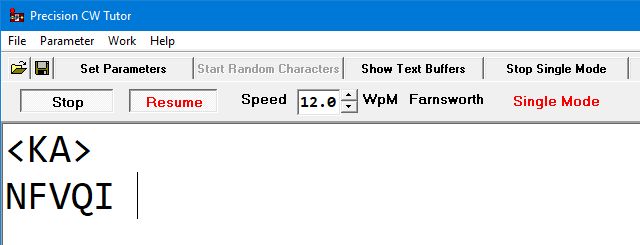
Once invoked with F9, the sounding of Morse characters stops whenever a blank space or a new line is found. In Random Phrases Mode it only stops when a new line is found. The (inactivated) Pause button then turns into a Resume button.
Then you have two choices: (1) you can press RTN or ENTER key (or the Pause key or click on the Resume button) to hear the next group or word, or (2) you can press CTRL+F9 or the BACKSPACE key to hear the last group, word or phrase again.
Now, let's see what happens when we use Single Mode together with Sound first, then show:
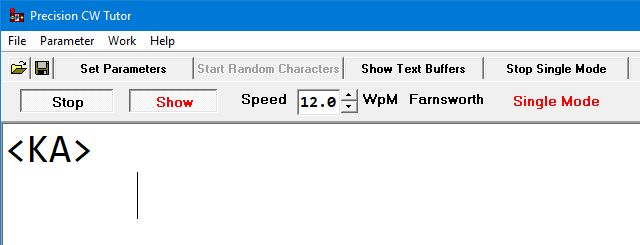
Here you have heard the first five random characters in the first group being sounded, but you don't see any of the characters on the screen. Instead, the inactivated Pause button has turned into a Show button.
Now you have two choices: when you hit BACKSPACE (or CTRL+F9), you can hear the past characters again, and again, as often as you need to. Only when you hit the RTN or Pause) key, the characters are shown on the screen and the Show button turns into the Resume button we have seen before.
When a session ends normally or when it is is aborted, then Single Mode is automatically ended.
Obviously, this Single Mode does not make much sense when the Speed Test is running, and therefore it is automatically removed when the speed test is started.
In Random Groups Mode, in Random Q-Code Mode, or in Random Words Mode you can select to render each item once, or to repeat each item up to 5 times. This can help you to intensify your learning experience.
You can select the number of individual repetitions in the center of the left pane on the Set Parameters window.
This Repeat function is not available for Random Phrases Mode or Text from File Mode, but it does well work together with Single Mode.

Text Buffers are a means to enter pre-defined text into your type-ahead window. When you see the main window, press F4 or click on the Text Buffers button. A new window will appear.
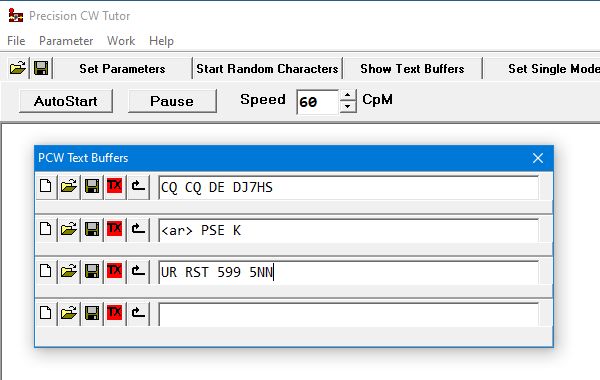
You see four separate horizontal panels representing four separate text buffers. Each buffer can
hold up to 60 characters, the field to the right shows the entered text.
All four text buffers are empty when you start the program for the first time. For clarity, I have entered some text
into the first three buffers.
In a training session, or when you use PCW Tutor as a Morse keyer, you can enter the contents of each of the four buffers 1..4 into the main window by simply pressing one of the F5, F6, F7, or F8 function keys.
To the left of each text buffer there are five different buttons. Put your mouse over one of these buttons and you will get a short help hint.
The leftmost button erases the content of the buffer. The next button is for loading the
buffer's content from a file, while the following button allows to save the content to a file.
Once you click on the red button, the content of that buffer is entered into the main window.
When the last button is depressed and turned red, the buffer's content is repeatedly entered into
the main window, until this button is released.
Of course, only those characters that have a Morse code representation are actually transferred to
the main window and converted to Morse output.
Buffer files are pre-named
CWBuffer1.txt ... CWBuffer4.txt,
but you can use any filename and any file containing ASCII characters.
If you need separate access to these files, you should typically find them in this location:
C:\Users\<your username>\AppData\Roaming\
On some systems this directory may have the "hidden" property.
When you terminate a session with PCW-Tutor, the current contents of all four text buffers are written into the files with the default file names. And when you start the next session, the contents of all four buffers are filled by reading from these files.
Go to top.Yes - this is equivalent to typing the text, and there are basically two ways to do that:
First, you can click on the Load text icon, select Load text from file from the File menu, or press CTRL+L. Then select the location and the name of the file you want to load. When the file exists, data is read and those characters that have a Morse representation are loaded into the type-ahead buffer and shown on the main window. Of course, this also depends on your previous choice of either the standard or the extended character set.
The type-ahead buffer can hold up to 30000 characters. At a Morse speed of 120 cpm that would mean more than 4 hours of work with Morse code. If your loaded file contains more than 30000 characters, then loading is stopped and a warning message appears: "Type-ahead buffer is full: 30000".
When you are loading from a large file, then loading and parsing of the text data can take some time. You can interrupt this process by pressing the ESC key.
When loading text from a file, characters defined as keyboard shortcuts for prosigns (described here) are discarded and not processed as prosigns. But there are three exceptions: the characters "-", "=" and "+" are used and converted into the respective prosigns <DU>, <BT> and <AR>. Therefore, if you want to use prosigns in text files, you have to write them with angle brackets < >, except "-", "=" and "+", of course.
A special treatment is applied when the loaded data actually contains prosigns with angle brackets. Valid 2-letter or 3-letter prosigns are retained, while invalid 1-letter, 2-letter or 3-letter combinations with < > angle brackets are discarded. When there are more than 3 letters between angle brackets or when there is a single angle bracket standing alone, then only the brackets are removed.
When AutoStart is selected, then conversion of text data to Morse characters will start immediately and go on until the end of file is reached, unless you pause or interrupt it as described in the How do I start working? chapter. When ManualStart is selected, then the conversion will only start when you click on the ManualStart button.
Note: The Number of Groups setting on the Set PCW Parameters Window is not used when reading from a file into the type-ahead buffer.
Default location for files to load data from is the %AppData% directory, typically found under:
c:\users\<your-username>\
When you choose a different location, then that location will be remembered.
A further way to load a number of characters into the main window is using the Windows clipboard. Any text that you have copied from elsewhere with CTRL+C can be added to the Main window with CTRL+V. This text will be added at the end of the current text in the main window.
Go to top.To save the text in the main window, click on the Save text icon, select Save as from the File menu or press CTRL+S, then select the name of the file you want to save the data to. When the file already exists, you have to confirm that it will be overwritten.
Default location to save to is the %AppData% directory, typically found under:
c:\users\<your-username>\
When you choose a different location, then that location will be remembered.
You may receive an error message saying that a file with a name, you were trying to save to, was not found.
This error message is caused by the Windows security system and the protection against ransomware. Very probably
you have received at the same time a corresponding message from the system, that you can reach by clicking on
the message button in the bottom-right corner on your screen.
Windows normally prevents 3rd party software from storing files into certain areas on your PC, like the "Documents" folder.
But there are two workarounds: you can either try to store your file onto a different location on your PC, e.g.
to an USB stick, or you can go to the Windows security application and specifically give PCW Tutor the right
to save files into normally forbidden areas.
A further way to save text from the main window uses the Windows clipboard: mark the text you want to transfer with mouse or cursor keys, then press CTRL+C. The marked text will be copied to the clipboard and can be used by another application.
Go to top.By definition, a string of Morse characters has a linear structure with no further structuring elements. In order to display it on a monitor screen, the string of characters has to be broken down according to the width of the program window. PCW-Tutor lets you structure the text by pressing the carriage return key. That adds a line break on the screen and is equivalent to an inter-word gap.
As space on a monitor screen is limited, only that much text is displayed as will fit on the window. If you want to see more, then resize the window or maximize it. You can also reduce the font size to a smaller value.
If you still can't see all you have typed and sent, you can use the PageUp or PageDown keys or the scroll bar at the right to move around on the main window.
Go to top.
Did you ever hear a sound from your PC or laptop? Do you hear the sound of Windows messages?
Are headphones or something else plugged into the headphone jack?
If at all possible, try to use a different program for any audio playback. Why not listen to
a good piece of mp3 music for a moment?
If you still can't hear the sound of any Morse characters, then either go to the parameters window (hit F2), then click on the Get Output Mixer button, or select Parameter, then Get Output Mixer from the main menu. This will bring up something that belongs to the Windows operating system and may look different on your PC, e.g. this one shown is from a German version of Windows 10.

On the left you have the total audio output level for loudspeaker, and somewhere to the right there should be the level slider for PCW-Tutor output. Both sliders should not be way down and there should not be red signs near the small loudspeaker symbols. Get the sliders up and uncheck any suspicious checkbox. Now you should hear the Morse output.
Go to top.This special sound is there to alert you and signal the end of a phrase in Phrase Mode. On the screen this sound is represented by the caret character "^". You can enable this sound by selecting the checkbox labeled 'Blip' after Phrase on the left parameters panel.
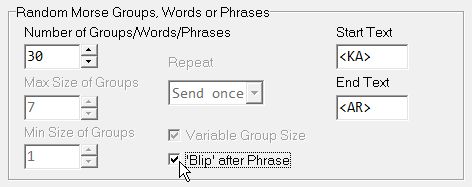
Please note that this alert sound is only available when you have selected Morse output via the sound interface. It is of course not available when you have selected Morse output via a COM port.
Go to top.In order to key an external device like an external buzzer or even a transmitter, you can use a serial
RS-232/COM interface. You first of all need to have such a serial communication interface on your PC.
Typically this can be identified by a 9-pin D-sub male socket. Such a socket is shown in the following picture.
If you don't see such a socket on your PC, you're not lost. You can as well use a RS-232-to-USB adapter that
plugs into a USB slot on your PC. Actually, the following picture shows a 9-pin D-sub male socket on such an
adapter.
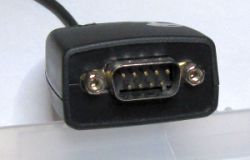
Next you need a kind of interface between your external device and this RS-232/COM interface on your PC. Such an interface can be as simple as one resistor and one small transistor, but the exact design very much depends on the device you want to control. There are a number of commercially available interfaces for this task, like MY-KEY-SERIAL2 by John Clements, KC9ON, that has an output for keying an external device.
As there is no standardization for such interfaces, the connections may not match in the first place. So you may need to do some experimentation. Here is basic information about how PCW Tutor controls the RS-232/COM output:
The Morse standard character set as supported by PCW Tutor is:
If you select the extended character set, then the following characters are supported in addition:
This last character is indeed a well-defined Morse character representing two consecutive letters, a "c" and an "h". In order to make a clear distinction between this character "ch" and separate characters "c" and "h", this character is displayed and otherwise handled like a prosign <CH>, although - strictly - it is not a prosign.
Some of these characters are only available on foreign keyboards.
On so-called QWERTZ-keyboards, typically used in Germany, two keystrokes are needed to produce the Morse pattern for question mark "?": "shift" key and "ß" key together. Therefore an optimization is provided: the Morse pattern for question mark can be reached without pressing the shift key, only the "ß" key needs to be pressed.
Go to top.International Morse code has been in use since 1848, and it has been used for all kinds of communication services.
And most, if not all of these services had to implement a way to signal an operational status like "Start of Message",
"End of Message", "Wait", and "Error, I repeat". And, naturally, a
Morse pattern was used for signalling. Of course, patterns had to be chosen that were easy to memorize and detect, but not
so easily mistaken for a Morse letter or numeral.
Operators quickly found out that these Procedural Signals
or Prosigns could be memorized by representing them as a sequence of two letters. And
one of the several ways to write them was to include these two letters into < > angle brackets.
Precision CW Tutor lets you use and generate the following set of prosigns. A few of these prosigns are also regularly used in Amateur Radio communication via Morse code, especially the first two on the list.
When you want to enter a prosign via the keyboard, you have two choices: you can either use a single-key abbreviation as given in the list,
or you can type an opening bracket and two letters, e.g. "<ar". Then the corresponding prosign
is produced and the closing bracket ">" is automatically added on the screen.
For the three-letter prosign <SOS> you can either type "{" or enter "<so". The
remaining letter and the closing bracket "s>" are then added automatically.
If you type an opening < bracket, followed by an invalid combination of letters, or when angle brackets with an invalid combination of characters between them are read from a file, then the input is ignored and only two angle brackets with a question mark <?> are printed on the screen.
These nine prosigns are currently supported:
As explained above, one Morse character in the extended character set is handled like a prosign:
When Samuel Finley Breeze Morse in 1837 invented the code system that is named after him (see e.g. US patent 1647), he actually devised a variable-length code. With such codes the concept of speed measured in codewords per time instant is difficult to handle, as speed actually depends on the information sent.
The International or Continental Morse Code, as opposed to the Landline or
American Morse Code, is also named after Samuel F.B. Morse, but it had actually
been devised in 1848 by a German named Friedrich Clemens Gerke.
He was a musician and journalist in Hamburg, where he worked for telegraph companies.
His code works according to simple and strict rules and was later and after some further adaptations
standardized by the ITU for use in wireless transmissions.
Gerke's code follows these rules:
Now, take the word "Paris", a word containing 5 characters. If you count all time elements you need for encoding this word, you end up with 50 time elements totally. When you send this word 12 times in 60 seconds, you have sent 12 words per minute or 60 characters per minute. And you will have used 600 time elements in 60 seconds. And, of course, 12 word spaces of 7 element length are included with these 600 elements. Then it is easy to calculate that a single time element must have a duration of 0.1 seconds or 100 ms.
This calculation is the basis for adjusting the speed of any Morse code generator. Of course, as you do not only want to send the word PARIS, any other text will take less or more than one minute for 12 words or 60 characters. Therefore the true speed can only be calculated after the message has been sent.
If you want to check the accuracy of PCW Tutor, and that of your PC's clocking, go to the main menu bar and select Work - Speed Test. The word PARIS will be sent 6 times and afterwards the actual speed will be calculated. This speed test is performed with the actual speed selected on the Main Window, but you can select any of the three Farnsworth modes: off, on-Characters or on-Words.
Go to top.Indeed, this is quite normal and should be expected. But why?
As stated in the last chapter, Morse code is a variable-length code. And therefore the true speed given in characters per time instant can only be given after a message has been sent, or calculated when the message is known.
The word PARIS is used as a typical word of normal English text. It has 5 letters and takes up 50 time elements, including the word space at the end. That means that the average length of a letter in this word is 10.
Now, when you take all 26 characters (a ... z) of the alphabet and calculate the average length of a character in a 5-letter word, you end up with an average length of 12.03 elements. When you take all numerals (0 ... 9) for the same calculation, you even get an average length of 17.8 elements.
All this means that only with normal text you can expect a final overall speed as adjusted at start. For groups of 5 random characters you should expect a lower final speed by a factor of 10/12.03 = 0.83, and for groups of 5 random numerals you should even expect a lower final speed by a factor of 10/17.8 = 0.56.
But the final speed must not always be lower, try a session with letters eish only. Their average length in a 5-letter word is 7.8 elements. So here you should expect a final overall speed that is higher by a factor of 10/7.8 = 1.28.
Go to top.
If you encounter a problem not covered on this help page, then please send an
EMail with a clear description of your problem.
Please allow for a reasonable response time, and don't forget to look into your spam folder. The answer may
come from a different mail account.
Any feedback is highly appreciated. Please send an EMail and describe what is missing or what you have found out.
Go to top.If you want to install a newer version of PCW Tutor, you have two choices:
You can simply install the new version over the existing version. This way all your settings in the Set PCW Parameters window will be left unchanged and used by the newer version.
Or you can first uninstall the existing version: Select "Start" - "Programs" from your task panel, then identify the entry for PCW-Tutor. Within this folder you will find a shortcut with the name Uninstall. Double-click and follow any instructions. Then you can install the newer version. This way you will have a clean new installation with all parameter values set to their default values.
Go to top.
That's easy: select "Start" - "Programs" from your task panel, then identify the entry for
PCW-Tutor. Within this folder you will find a shortcut with the
name Uninstall. Double-click and follow any instructions.
Voilá, Precision CW Tutor is removed from your system, very probably
without a trace.